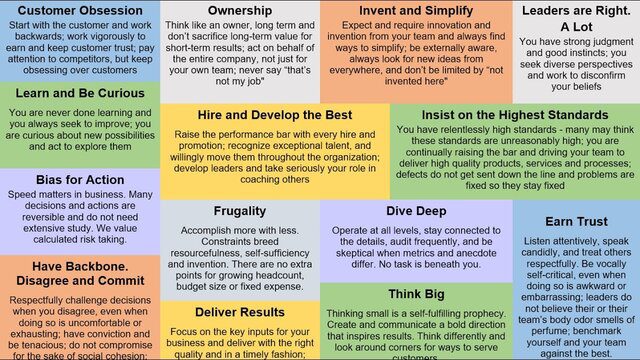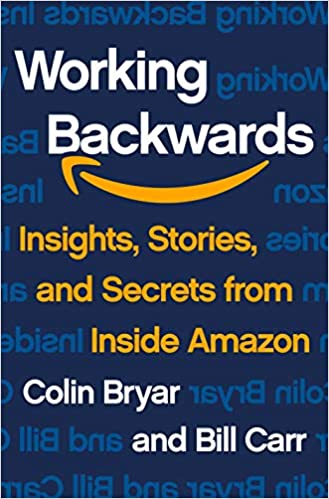Print | Kindle (eBook) | Audiobook
In Working Backwards, Collin and Bill share insights. stories and the principles that drove the success of Amazon to become one of the world’s most valuable brands. The Title of the book working back is derived from amazon’s product development process: working backwards from the desired customer experience. Amazon is the largest Internet company by revenue in the world. It is the second-largest private employer in the United States and one of the world’s most valuable companies. As of 2020, Amazon has the highest global brand valuation.
The authors illuminate how Amazon’s fourteen leadership principles inform decision-making at all levels and reveal how the company’s culture has been defined by four characteristics: customer obsession, long-term thinking, eagerness to invent, and operational excellence. Bryar and Carr explain the set of ground-level practices that ensure these are translated into action and flow through all aspects of the business.
The Title of the book working back is derived from amazon’s product development process: working backwards from the desired customer experience
Working Backwards is a practical guidebook and a corporate narrative, filled with the authors’ in-the-room recollections of what “Being Amazonian” is like and how it has affected their personal and professional lives. They demonstrate that success on Amazon’s scale is not achieved by the genius of any single leader, but rather through a commitment to and execution of a set of well-defined, rigorously executed principles and practices.
The Authors
Colin Bryar joined Amazon in 1998 and for two of his years at Amazon, he was the “Chief of Staff” to Jeff Bezos, AKA “Jeff’s shadow”, during which he spent each day attending meetings, traveling with, and discussing business and life.
Bill Carr joined Amazon in 1999 and spent more than 15 years with the company. As Vice President of Digital Media, Bill launched and managed the company’s global digital music and video businesses, including Amazon Music, Prime Video, and Amazon Studios.
Amazon according to Jeff Bezos:
In a talk at the 2018 Air, Space and Cyber Conference, Jeff described Amazon this way: “Our culture is four things: customer obsession instead of competitor obsession; willingness to think long term, with a longer investment horizon than most of our peers; eagerness to invent, which of course goes hand in hand with failure; and then, finally, taking professional pride in operational excellence.
In 2015 Amazon became the company that reached $100 billion in annual sales faster than any other in the world.
PLANT MANY SEEDS
“Jeff often used an analogy in those days when describing our efforts to innovate and build new businesses. “We need to plant many seeds,” he would say, “because we don’t know which one of those seeds will grow into a mighty oak.” It was an apt analogy. The oak is one of the sturdiest and longest-living trees in the forest. Each tree produces thousands of acorns for every one tree that eventually rises to the sky.”
Part One: Being Amazonian
The Bar Raiser
Urgency bias: the tendency to overlook a candidate’s flaws because you are overwhelmed with work and need bodies. The Bar Raiser provides teams with methods to make the strongest hires efficiently and quickly, but without cutting corners.
single-threaded leadership
The basic premise is, for each initiative or project, there is a single leader whose focus is that project and that project alone, and that leader oversees teams of people whose attention is similarly focused on that one project.
A single person, unencumbered by competing responsibilities, owns a single major initiative and heads up a separable, largely autonomous team to deliver its goals.
Working Backward
“Working Backwards from the desired customer experience. Before we start building, we write a Press Release to clearly define how the new idea or product will benefit customers, and we create a list of Frequently Asked Questions to resolve the tough issues up front. We carefully and critically study and modify each of these documents until we’re satisfied before we move on to the next step.”
The Working Backwards process is all about starting from the customer perspective and following a step-by-step process where you question assumptions relentlessly until you have a complete understanding of what you want to build. It’s about seeking truth.
Chapter 1 Building Blocks: Leadership Principles and Mechanisms
What distinguishes Amazon is that its Leadership Principles are deeply ingrained in every significant process and function at the company. In many cases, the principles dictate a way of thinking or doing work that is different from the way that most companies operate. As a result, newly hired Amazonians go through a challenging multimonth period of learning and adapting to these new methods.

Over the course of many years, Amazon has put in place mechanisms to ensure that the Leadership Principles translate into action. Three foundational mechanisms are
- The annual planning process;
- The S-Team goals process (the S-Team consists of the senior vice presidents and direct reports to Jeff Bezos); and
- Amazon’s compensation plan, which aligns incentives with what’s best for customers and the company over the long term.
Amazon relies heavily on autonomous, single-threaded teams. These teams keep the company nimble, moving quickly with a minimum of external friction, but their autonomy must be paired with precise goal-setting.to align each team’s independent plans with the company’s overarching goals.
Chapter 2 : Hiring
“Unstructured hiring decision meetings can give rise to groupthink, confirmation bias, and other cognitive traps that feel right at the time but produce poor decisions.”
The Amazon Bar Raiser program
The Amazon Bar Raiser program has the goal of creating a scalable, repeatable, formal process for consistently making appropriate and successful hiring decisions. Like all good processes, it’s simple to understand, can be easily taught to new people, does not depend on scarce resources (such as a single individual), and has a feedback loop to ensure continual improvement. The Bar Raiser hiring process became one of the earliest and most successful components of the being Amazonian toolkit.
“Amazon’s Bar Raiser process was designed to provide that framework, minimize the variability of ad hoc hiring processes, and improve results.”
STAR
“The method that Amazon interviewers use for drilling down goes by the acronym STAR (Situation, Task, Action, Result):
“What was the situation?”
“What were you tasked with?”
“What actions did you take?”
“What was the result?”
The Bar Raiser
The Bar Raiser is involved in every interview loop and ensures the process is followed and bad hiring decisions are avoided. They are also there to set a good example for other interviewers. In addition to conducting one of the interviews, the Bar Raiser coaches others on interviewing techniques, asks probing questions in the debrief, makes sure that personal biases do not affect the hiring decision, and determines whether the candidate meets or exceeds the hiring bar set by the company.
Two-Pizza Team
The two-pizza team, so named because the teams would be no larger than the number of people that could be adequately fed by two large pizzas.
Chapter 4: Communicating
Six Pager Document
At Amazon, after a brief exchange of greetings and chitchat, everyone sits at the table, and the room goes completely silent. Silent, as in not a word. The reason for the silence? A six-page document that everyone must read before discussion begins.
Amazon relies far more on the written word to develop and communicate ideas than most companies, and this difference makes for a huge competitive advantage.
Amazon uses two main forms of narrative.
The first is known as the “six-pager.” It is used to describe, review, or propose just about any type of idea, process, or business.
The second narrative form is the PR/FAQ. This one is specifically linked to the Working Backwards process for new product development.
Chapter 5: Working Backwards
Working Backwards is a systematic way to vet ideas and create new products. Its key tenet is to start by defining the customer experience, then iteratively work backwards from that point until the team achieves clarity of thought around what to build. Its principal tool is a second form of written narrative called the PR/FAQ, short for press release/frequently asked questions.
Chapter 6 Metrics: Manage Your Inputs, Not Your Outputs
The share price is what Amazon calls an “output metric.” The CEO, and companies in general, have very little ability to directly control output metrics. What’s really important is to focus on the “controllable input metrics,” the activities you directly control, which ultimately affect output metrics such as share price.
Weekly Business Review (WBR).
The purpose of the WBR was to provide a more comprehensive lens through which to see the business. The WBR is constructed and implemented so the company can improve each and every week. It has a fractal nature that allows us to easily adapt to different situations, from small groups to billion-dollar businesses. Small teams, business category lines, and the entire online retail business all have their own WBRs.
Input vs Output Metrics
Input metrics track things like selection, price, or convenience—factors that Amazon can control through actions such as adding items to the catalog, lowering cost so prices can be lowered, or positioning inventory to facilitate faster delivery to customers.
Output metrics—things like orders, revenue, and profit—are important, but they generally can’t be directly manipulated in a sustainable manner over the long term. Input metrics measure things that, done right, bring about the desired results in your output metrics.
Part Two: The Invention Machine at Work
Failing Forward
To invent you have to experiment, and if you know in advance that it’s going to work, it’s not an experiment. Most large organizations embrace the idea of the invention but are not willing to suffer the string of failed experiments necessary to get there. Thus for Amazon, its less successful inventions, such as Fire Phone, are valuable. The same is true of the off-target early iterations of later successes, such as Amazon Unbox, which evolved into Prime Video, and Amazon Auctions and zShops, which developed into Amazon Marketplace. These “failures” are important parts of the company’s story, both as precursors to later successes and as evidence that experimentation is happening.
Being Amazonian
Being Amazonian means approaching invention with long-term thinking and customer obsession, ensuring that the Leadership Principles guide the way, and deploying the practices to drive execution.
Long-term thinking levers our existing abilities and lets us do new things we couldn’t otherwise contemplate. – Jeff Bezos
Slow Down
You can’t wind the clock back, replay the experiment, and see what would have happened if we had built and launched these services quickly without knowing some of the truths we discovered using Working Backwards. However, though there were still some post-launch maintenance issues and outages, the performance and rapid customer adoption speak for themselves. Based on my experience of going through the Working Backwards process with Jeff for well over a dozen different product teams across AWS, Digital, and other services,
“I can say confidently that the extra time we spent slowing down to uncover the necessary truths was ultimately a faster path to a large and successful business. The results speak for themselves. Amazon has large viable digital devices and media businesses. And, as mentioned in the introduction, AWS reached the $10 billion annual revenue milestone faster than Amazon the online retailer.”
Suggestion to being Amazonian
Ban PowerPoint as a tool to discuss complicated topics and start using six-page narratives and PR/FAQ documents in your leadership team meetings. This can be implemented almost instantly. There will be pushback and grumbling, but we’ve found it produces results swiftly, and eventually your leaders will say to themselves, “We can never go back to the old way.
Establish the Bar Raiser hiring process.
This approach is no longer unique to Amazon and we have seen it work in many companies. It too can be established relatively quickly, once a training process is in place. It also delivers short-term results by improving the quality of the process and enabling learning for everyone involved in the loop. It should reduce the number of poor hires and, in the long run, improve the overall quality of thinking and performance in each team, and in the company as a whole.
Focus on controllable input metrics.
Amazon is relentless about identifying metrics that can be controlled and have the greatest impact on outputs such as free cash flow per share. This is not an easy process, because it requires patient trial and error as you seek the input metrics that best allow you to assume control of your desired results. Note too that this is not an argument for abandoning output metrics. Amazon does care a great deal about free cash flow per share.
Move to an organizational structure that accommodates autonomous teams with single-threaded leaders.
This takes time and requires careful management, as it invariably raises questions about authority and power, jurisdiction, and “turf.” You’ll also have to be on the lookout for dependencies and roadblocks that are preventing autonomy in your organization. But it can be done. Start with your product development group, and then see what other areas, if any, work better in teams.
Revise the compensation structure for leaders so that it encourages long-term commitment and long-term decision-making. Avoid making too many exceptions for “special cases.” Make sure that leaders in all areas of the company are compensated with the same basic approach.
Articulate the core elements of the company’s culture, as Amazon did with long-term thinking, customer obsession, eagerness to invent, and operational excellence. Then build these into every process and discussion. Do not assume that simply stating them and displaying them will have any significant effect.
Define a set of leadership principles.
These must be developed with participation from many contributors. Don’t assign the task to a single group or outsource it to a consultant or service provider. Do it yourselves. Hash out the details. Revisit the principles from time to time and revise if and as necessary. Then, as with the aspects of the culture, bring the principles into every process, from hiring to product development.
Depict your flywheel. What are the drivers of growth for your company? Make a picture of them that shows how they act upon the flywheel. Evaluate everything you do in light of its positive or negative effect on one or more drivers of the flywheel.”
All the Best in your quest to get Better. Don’t Settle: Live with Passion.



1 Comment
Pingback: 100 Books Reading Challenge 2021 – Lanre Dahunsi